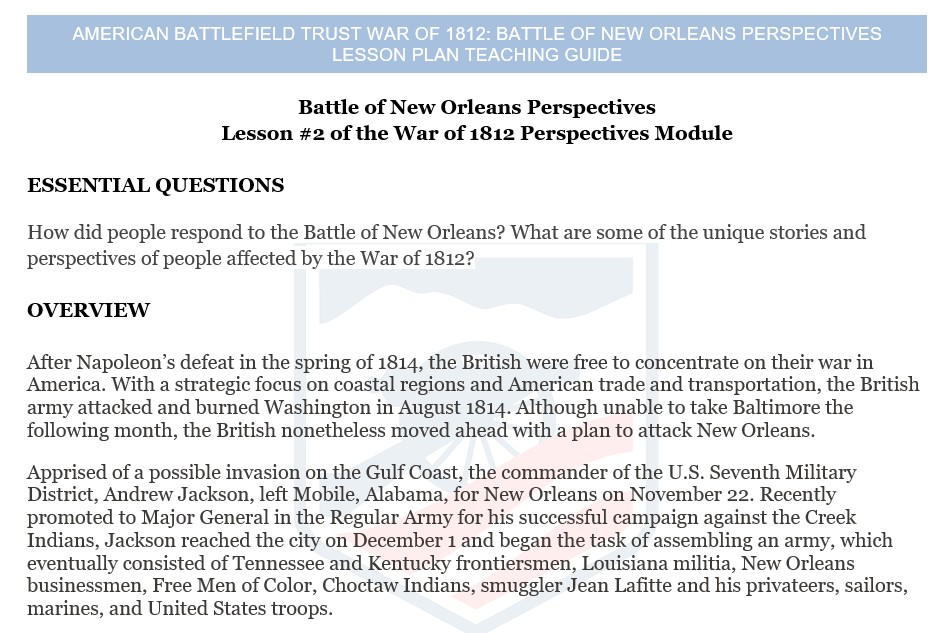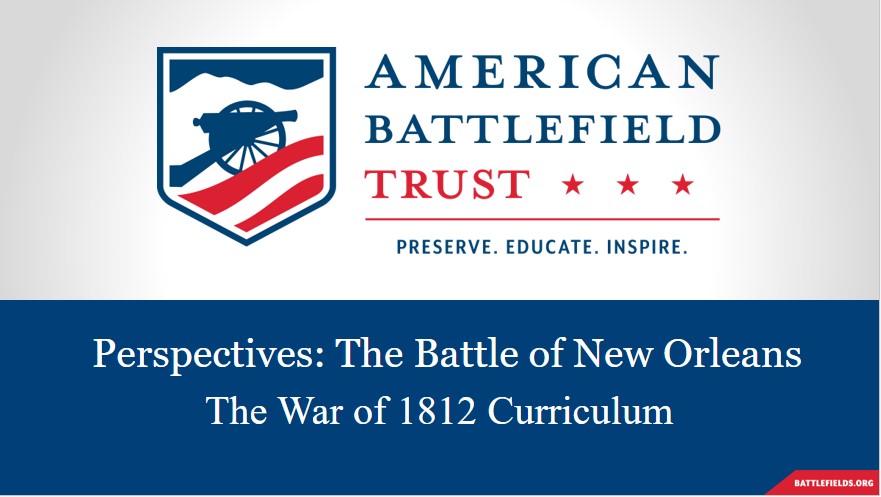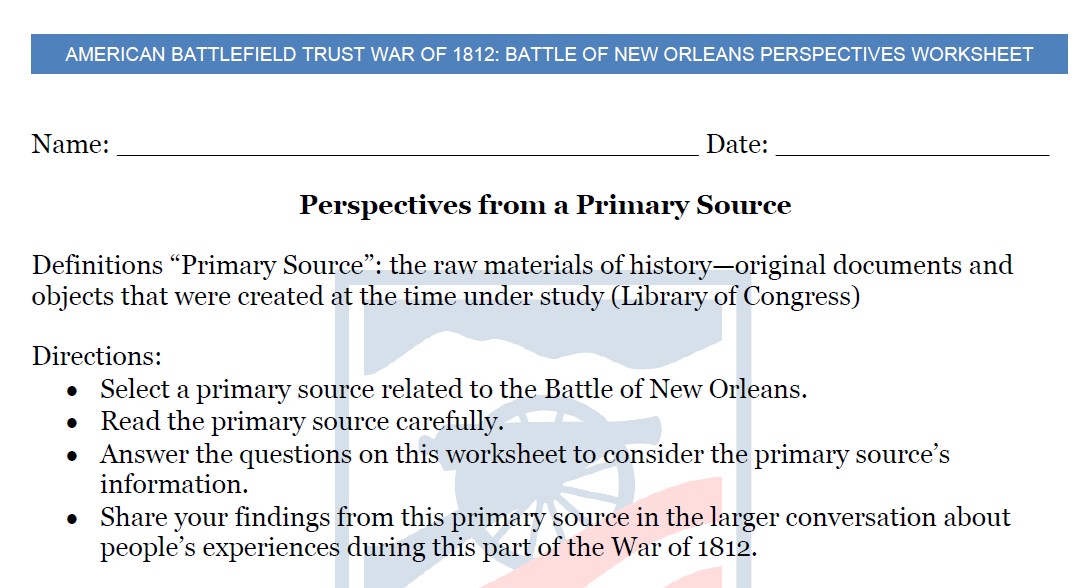War of 1812: Battle of New Orleans Perspectives Lesson Plan
A lesson plan for use in middle and high school classrooms.
On January 8, 1815, Major General Andrew Jackson's hastily assembled army won the fight against a battle-hardened and numerically superior British force. The British gambled and lost on a forward attack against American forces, dug into a fortified mud and cotton bale earthworks on the east bank of the Mississippi at Chalmette Plantation. British casualties far outnumbered those of the Americans. The resounding American victory at the Battle of New Orleans soon became a symbol of American democracy triumphing over the old European ideas of aristocracy and entitlement. Jackson's triumph set him on a road that ended in the White House thirteen years later. The battle was the last major armed engagement between the United States and Britain.
This Lesson Plan can be used as a prepared resource by following this curriculum plan which aligns to NCSS and Common Core Standards.
This Lesson Plan's assets can also be used on their own as supplemental resources. The display format is prepared for easy access, exploring, and learning.
War of 1812 Perspectives Module
Upon completion of this lesson, the students will be able to:
OBJECTIVES
Upon completion of this lesson, the students will be able to:
1. Knowledge
- Briefly explain the Battle of New Orleans and its outcomes.
2. Comprehension/Application/Analysis
- Examine multiple primary sources to gain an appreciate for the American and British perspectives and experiences during and after the Battle of New Orleans.
3. Evaluation
- Discuss findings from primary sources and consider how the Battle of New Orleans affected the soldiers and civilian population.
Check out the Lesson Plan Teaching Guide for more instructions on using the prepared Lesson Plan.
Lesson Plan Primary Source Activity:
1. Use the Lesson’s PowerPoint to explore the context and history, laying foundational knowledge the War of 1812 and the Battle of New Orleans.
2. The primary sources for this perspectives lesson plan offer multiple perspectives on the battle and its outcomes for individuals and the city of New Orleans; students can be divided into groups to read and fill out the worksheet.
| Battle of New Orleans | "To Describe Those Lines" |
| Battle of New Orleans | "Pakenham Gave the Word to Advance" |
| After the Battle | "In Praise of the Firmness and Deliberation" |
| After the Battle | "Bravely Facing the Dangers of War" |
| After the Battle | "They threw themselves on his protection" |
| After the Battle | "Address of General Jackson to the Soldiers and Citizens at New Orleans" |
| After the Battle | A Tribute to defenders of New Orleans |
3. Distribute the lesson’s worksheet.
4. Students will read a primary source and fill out the worksheet which will guide them through exploring the document.
5. Encourage a class discussion and draw group conclusions, answering the questions:
- How did people respond to the Battle of New Orleans?
- What are some of the unique stories and perspectives of people affected by the War of 1812 in New Orleans?
OPTIONAL HOMEWORK/ASSESSMENT/ADDITIONAL ACTIVITIES:
Option 1: Biography Study
Have the students selected a historical person connected to the Battle of New Orleans. (There are six biography articles already prepared on the Lesson Plan Page). The students will read the biography and make notes for the following topics. Students can write a short essay, share their findings verbally, or incorporate their findings into a larger class project that might include art, costumes, or props.
Key Life Events:
- Identify and describe three key events or milestones in the life of the individual. How did these events shape or influence their character, achievements, or contributions?
Role in the Chesapeake Campaign
- What did this person do during the Battle of New Orleans? Does this seem to be a significant moment in this person’s life?
Legacy and Impact:
- Reflect on the individual's lasting legacy and impact on society. What are the person's major contributions or accomplishments? Do you think these accomplishments were good? How have their actions influenced the course of history or inspired others?
Option 2: New Orleans Virtual Field Trip
Students can watch the New Orleans Virtual Field Trip, which tours historic New Orleans and Chalmette Battlefield in Louisiana. Students can then write a short essay about a place of interest that they saw in the video. For additional resources related to the New Orleans Virtual Field Trip, including more information about featured sites, please visit this resource hub/landing page.
Common Core State Standards- ELA & History/Social Studies
Grades 6-8
- Key Ideas and Details:
- CCSS.ELA-LITERACY.RH.6-8.1
- Cite specific textual evidence to support analysis of primary and secondary sources.
- CCSS.ELA-LITERACY.RH.6-8.2
- Determine the central ideas or information of a primary or secondary source; provide an accurate summary of the source distinct from prior knowledge or opinions.
- CCSS.ELA-LITERACY.RH.6-8.1
- Craft and Structure:
- CCSS.ELA-LITERACY.RH.6-8.6
- Identify aspects of a text that reveal an author's point of view or purpose (e.g., loaded language, inclusion or avoidance of particular facts).
- CCSS.ELA-LITERACY.RH.6-8.6
- Integration of Knowledge and Ideas:
- CCSS.ELA-LITERACY.RH.6-8.8
- Distinguish among fact, opinion, and reasoned judgment in a text.
- CCSS.ELA-LITERACY.RH.6-8.8
Grades 9-10
- Key Ideas and Details:
- CCSS.ELA-LITERACY.RH.9-10.1
- Cite specific textual evidence to support analysis of primary and secondary sources, attending to such features as the date and origin of the information.
- CCSS.ELA-LITERACY.RH.9-10.2
- Determine the central ideas or information of a primary or secondary source; provide an accurate summary of how key events or ideas develop over the course of the text.
- CCSS.ELA-LITERACY.RH.9-10.3
- Analyze in detail a series of events described in a text; determine whether earlier events caused later ones or simply preceded them.
- CCSS.ELA-LITERACY.RH.9-10.1
- Craft and Structure:
- CCSS.ELA-LITERACY.RH.9-10.5
- Analyze how a text uses structure to emphasize key points or advance an explanation or analysis.
- CCSS.ELA-LITERACY.RH.9-10.6
- Compare the point of view of two or more authors for how they treat the same or similar topics, including which details they include and emphasize in their respective accounts.
- CCSS.ELA-LITERACY.RH.9-10.5
- Integration of Knowledge and Ideas:
- CCSS.ELA-LITERACY.RH.9-10.8
- Assess the extent to which the reasoning and evidence in a text support the author's claims.
- CCSS.ELA-LITERACY.RH.9-10.9
- Compare and contrast treatments of the same topic in several primary and secondary sources.
- CCSS.ELA-LITERACY.RH.9-10.8
Grades 11-12
- Key Ideas and Details:
- CCSS.ELA-LITERACY.RH.11-12.1
- Cite specific textual evidence to support analysis of primary and secondary sources, connecting insights gained from specific details to an understanding of the text as a whole.
- CCSS.ELA-LITERACY.RH.11-12.2
- Determine the central ideas or information of a primary or secondary source; provide an accurate summary that makes clear the relationships among the key details and ideas.
- CCSS.ELA-LITERACY.RH.11-12.3
- Evaluate various explanations for actions or events and determine which explanation best accords with textual evidence, acknowledging where the text leaves matters uncertain.
Craft and Structure:
- Evaluate various explanations for actions or events and determine which explanation best accords with textual evidence, acknowledging where the text leaves matters uncertain.
- CCSS.ELA-LITERACY.RH.11-12.6
- Evaluate authors' differing points of view on the same historical event or issue by assessing the authors' claims, reasoning, and evidence.
- CCSS.ELA-LITERACY.RH.11-12.1
- Integration of Knowledge and Ideas:
- CCSS.ELA-LITERACY.RH.11-12.8
- Evaluate an author's premises, claims, and evidence by corroborating or challenging them with other information.
- CCSS.ELA-LITERACY.RH.11-12.9
- Integrate information from diverse sources, both primary and secondary, into a coherent understanding of an idea or event, noting discrepancies among sources.
- CCSS.ELA-LITERACY.RH.11-12.8
Social Studies - National Council for the Social Studies
- Theme 3: People, Places, and Environments
- Theme 4: Individual Development and Identity
- Theme 5: Individuals, Groups, and Institutions
- Theme 6: Power, Authority, and Governance
- Theme 9: Global Connections
This Lesson plan
contains the following:
3 Activities | 19 Resources
Audience: Middle school | High school







